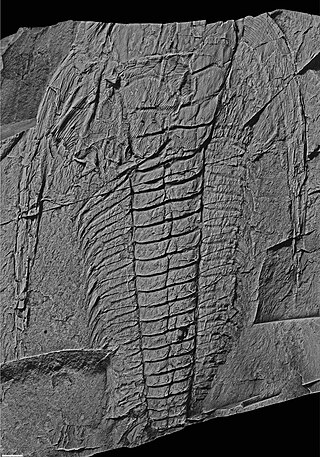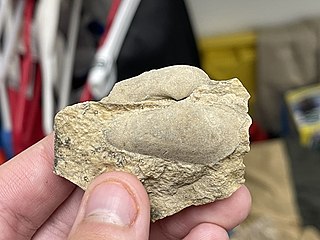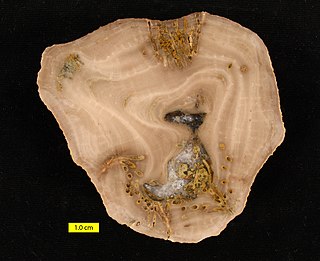
The Silurian is a geologic period and system spanning 24.6 million years from the end of the Ordovician Period, at 443.8 million years ago (Mya), to the beginning of the Devonian Period, 419.2 Mya. The Silurian is the shortest period of the Paleozoic Era. As with other geologic periods, the rock beds that define the period's start and end are well identified, but the exact dates are uncertain by a few million years. The base of the Silurian is set at a series of major Ordovician–Silurian extinction events when up to 60% of marine genera were wiped out.

Orthoceras is a genus of extinct nautiloid cephalopod restricted to Middle Ordovician-aged marine limestones of the Baltic States and Sweden. This genus is sometimes called Orthoceratites. Note it is sometimes misspelled as Orthocera, Orthocerus or Orthoceros.

John William Salter was an English naturalist, geologist, and palaeontologist.

Promissum is an extinct genus of conodonts, primitive chordates, that lived during the Upper Ordovician period.
Camarotoechia is an extinct genus of brachiopods found in Paleozoic strata.

The Bromide Formation is a geological formation in Oklahoma, USA. It is well known for its diverse echinoderm and trilobite fossil fauna.

Similodonta is an extinct genus of early bivalve in the extinct family Praenuculidae. The genus is one of eleven genera in the subfamily Praenuculinae. Similodonta is known from Middle Ordovician through Middle Silurian fossils found in Europe and North America. The genus currently contains eight accepted species, Similodonta ceryx, Similodonta collina, Similodonta djupvikensis, Similodonta magna, Similodonta recurva, Similodonta spjeldnaesi, Similodonta wahli and the type species Similodonta similis.

Amplexopora is a genus of bryozoans of the family Amplexoporidae, known in the rock record from the Ordovician to the Permian periods. Species belonging to this genus were stationary epifaunal suspension feeders. Their colonies showed a very great variety in shapes.
Madeleine Alberta Fritz was a Canadian palaeontologist. She was a professor at the University of Toronto, where she taught vertebrate studies in the department of Geology. Fritz's writing on the fossil Bryozoa along with her research on the stratigraphy of Toronto and the surrounding areas were major contributions to the geological field.
Iapetognathus is a genus of cordylodan conodonts. It is one of the oldest denticulate euconodont genera known.
Cornuodus is an extinct genus of conodonts.
Notiodella is an extinct conodont genus in the family Balognathidae. It has been described from a 17-element apparatus from the Soom Shale Lagerstätte in South Africa.
Amorphognathus is an extinct conodont genus in the family Balognathidae from the Ordovician.
Appalachignathus is a genus of multielement conodonts from the Middle Ordovician of North America.
Prioniodus is an extinct genus of conodonts in the family Balognathidae from the Ordovician.
Microzarkodina is an extinct genus of conodonts mainly from the Middle Ordovician of Baltoscandia. The Microzarkodina apparatus probably consisted of 15 or 17 elements: four P, two or four M and nine S elements. The S elements include different Sa, Sb1, Sb2, and Sc element types.

Histiodella is an extinct genus of conodonts.
Eridotrypa is an extinct genus of bryozoans of the family Aisenvergiidae, consistently forming colonies made of thin branches. Diaphragms are very common in colonies. Distinctively, in the exozone there are serrated dark borders separating the autozooecia.
Cyphotrypa is an extinct genus of Ordovician bryozoan. Its colonies form hemispherical shapes, with flat undersides and rounded tops. In cross-section, the zooecia fan out from the initial growth area and intersect the rounded top surface of the colony at right angles. A few scattered maculae are present, composed of a few zooecia larger than the others with mesopore-like apertures.
Monticuliporidae is a family of bryozoans belonging to the order Trepostomata, characterized by branching, encrusting, or massive colonies with regularly spaced bumps on their surfaces. It is one of the earliest bryozoan families to arise, known from the early Ordovician period, but disappears from the fossil record after the late Silurian period. Monticuliporidae had a widespread geographical range and many genera had cosmopolitan distribution.







